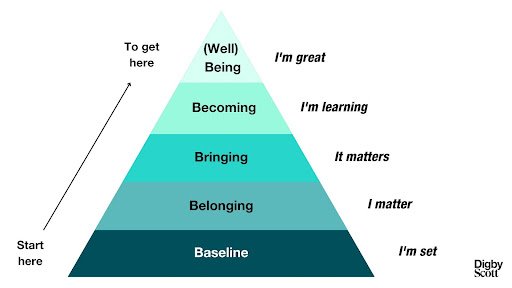The Five B’s for Thriving at Work
Do you know how to create the conditions for you, and the people you lead, to thrive at work? In a world of work that’s ever-changing, some things remain the same. This post is about some of those things.
I want to give you a simple, practical tool to help you create the conditions for engagement and sustained good work. I created this tool in 2020 after I came across some useful research, conveniently grounded in neuroscience. I’ve been using this tool ever since in my leadership programmes, workshops and webinars. People find it a useful way to reflect on, and to get into conversation about, what it takes to be at your best at work.
The idea
When we get our core needs met, we’re more likely to be at our best. (This idea is nothing new: Maslow nailed it with his hierarchy of needs, and he was building on centuries of insight).
The detail
In social settings like work, we all have some fundamental psychological needs. These are:
Belonging: the need to matter to others.
Bringing: the need to bring your skills and talents to work that matters
Becoming: the need to learn and grow
We want to be able to create the conditions where we can say ‘yes’ to these questions:
Do you feel like you matter here?
Do you have the opportunity to apply your talents to meaningful work here?
Do you feel like you’re learning and growing here?
But wait! There’s another ‘B’: Baseline. To consistently be at our best, we all have to get some core personal and organisational elements sorted. Things like quality sleep, exercise and a good diet. And at work, we need the tools and environment to be able do the job.
The model
Putting it all together, it looks like this:
By paying deliberate attention to these four B’s, you get a fifth B: Being. That’s short for wellbeing, which is the state we want to be in. In other words: thriving.
For a team or organisational lens, you can swap out the ‘I’ and ‘I’m’ for ‘We’ and ‘We’re’.
The tool
Here’s a snapshot of the tool:
It’s a self-assessment that helps to identify where you’re good, and where things might need shoring up. It invites you to rate each element, and then identify how you might strengthen each one, both for you, and for others.
You can download the tool here.
The application
How might you use this? Here are four stater ideas:
For your own reflective practice
In your one-ones
In mentoring conversations
As a team health check
Bonus: since you’ve read this far, you might like to check out my six minute video walkthrough of the model. I suspect It’ll bring it to life just that bit more for you.
I hope you find this useful. I’d love to hear how you use it and what difference it makes. Drop me a line sometime.
For more like this, check out:



